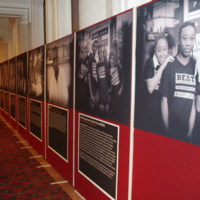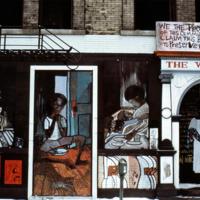
Freedom Roads
The Freedom Roads exhibition at Guildhall Art Gallery was one of several initiatives led by London Metropolitan Archives to mark the bicentenary. The exhibition featured contemporary photographic portraits of people of African origin whose work has contributed to the continuing struggle for human rights in different fields. Colin Prescod, Shirley Thompson, Eric and Jessica Huntley and Rudolph Walker were amongst the individuals featured. Others like the young people from BEAT (Black Experience Archive Trust) were engaged in a project to find out about significant people in their local community. Each person was photographed with an image of an object or place which has a special significance to them. The other part of the exhibition focused on relevant archival materials held by London Metropolitan Archives, including the South African Bill of Rights and a copy of the Constitution signed by Nelson Mandela, Cyril Ramaphosa, F. W. De Klerk and Roelf Meyer. Other material relating to slavery and abolition included a letter from John Julius, a plantation owner on the island of St. Kitts.

Wall of Truth
Although sharing an address with the famous Wall of Respect, the Wall of Truth was different. Whilst the Wall of Respect exalted black role models, leaders and liberators, the Wall of Truth wove negative scenes of poverty, brutality and racism into the fabric of the urban environment. Rather than promoting racial pride, it highlighted racial disparities. “The intent on the opposite side [of the road] was that things had gone more militant,” muralist Eugene Wade explained: “more blackness was needed in terms of representing the Black Power symbol and the whole thrust of what was happening in the black community.” Wade notes that “people were getting angry and fed up, so what we were trying to do was implement the attitude and the mood."The Wall of Truth was a significantly larger mural than its Chicago neighbour, the Wall of Respect. It spanned the length of an apartment building, and wrapped around onto an adjoining wall. It contained nine separate narrative panels and was one of the first instances that a radical black past was visualised in the streets through the antislavery leaders Frederick Douglass and Nathaniel Turner, as well as Mary McLeod Bethune, W.E.B. Du Bois, H. Rap Brown, Stokely Carmichael, Marcus Garvey, Huey P. Newton, Fred Hampton, and Malcolm X.